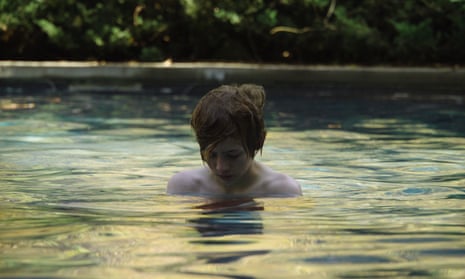What does it feel like to be an adult? That’s the question haunting a privileged, empathy-free adolescent in this chillingly satirical feature from the Spanish film-maker and visual artist Pascual Sisto. Adapted by screenwriter and co-producer Nicolás Giacobone (whose screen credits include Biutiful and Birdman) from his short story El Pozo, John and the Hole combines riffs from dime-a-dozen entrapment horrors with the absurdist unease of European art-house cinema and a strong thread of fairytale yarn-spinning. While the result may not be quite as deep as the cavern at the centre of the story, it has an enticing sliver of ice at its heart.
Sisto opens with a 4x3 closeup on the face of 13-year-old John ( Charlie Shotwell, star of the 2019 horror Eli) as an offscreen teacher demands: “What’s the square root of 225?” “I don’t know,” John replies, having been apparently lost in his own thoughts. “Yes, you do, John,” the teacher’s voice insists, prompting him to blurt out “15”. “How did you arrive at that conclusion?” “I don’t know...” It’s an enigmatic curtain-raiser that compactly establishes the key elements of the story: John’s numbed isolation (he is the only distinguishable figure in the frame); the anxiety of youth (his eyes betray a hint of panic); his intelligence, matched with a lack of understanding (he knows the answer, but doesn’t know how).
Having laid out its twisted coming-of-age table, the film proceeds in creepily deadpan fashion. We meet John’s family through the windows of their fish-tank house, cinematographer Paul Özgür’s camera peering prowler-like from adjacent woodlands as they eat their distanced dinner. They’re a typical dysfunctional unit. Jennifer Ehle’s Anna takes sleeping pills that John samples and later deploys to devious ends. Dad Brad (Michael C Hall) worries about Josh, the unseen boy who shows up to date his daughter, Laurie (Taissa Farmiga). Meanwhile, John flies a drone over the forest, discovering the remnants of an unfinished bunker. As his parents explain: “Sometimes people build these underground homes… in case something bad happens.” Little do they realise that something “bad” is indeed afoot, as their affectless son figures a way to become the man of the house.
Along with hints of the Austrian psycho-drama Goodnight Mommy, there are eerie echoes of Christine Molloy and Joe Lawlor’s Helen as we follow the yellow T-shirted John into dense green woods. Back in the house, we’re in Haneke-land, with still-frame, long-take images of bourgeois life, haunted by the ghosts of the alarming 1992 drama Benny’s Video. Hiding behind his fringe, Shotwell invests John with a blend of inquisitiveness and insularity, displaying the same quizzical boredom whether bouncing a tennis ball on the ceiling or putting his family addown in the hole.
Freed from parental attention, John’s adventures in adultland are disturbingly mundane – driving the family car, using a cash machine, making risotto. At one point he appears to make a clumsy pass at a visiting fiftysomething family friend, but even this seems simply like an attempt to mimic something that adults would do. For the most part he’s more interested in the asphyxiating rituals of drowning, childishly searching for the meaning of life in visions of the Virgin Mary in a swimsuit.
Perhaps most intriguing is the fact that, 30 minutes in, Sisto and Giacobone unexpectedly shift their attention away from the main story to that of another youngster, Lily, who dreams of being “blue in the blue” – invisible. Like a character from a Brothers Grimm fable, Lily’s mother is about to abandon her, telling this 12-year-old (“I thought you were 13”) that she is “old enough to be on your own now”. But first she tells her a story – the Story of John and the Hole, thus giving Sisto’s film a longer pre-title sequence than No Time to Die and adding a Pirandello-esque twist to Anna’s question: “Is someone making you do this?”
Sequenced musical cues by Caterina Barbieri act like a horror-tinged counterpoint to Scottish composer Anna Meredith’s work on Eighth Grade, while superb sound design by Nicolas Becker (Oscar-garlanded for Sound of Metal) captures the alien landscape of John’s inner world, filled with unsettling buzzing sounds, both natural and mechanical.
